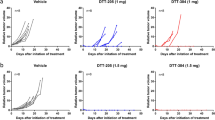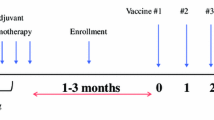Abstract
We established an orthotopic animal model of colon cancer in mice and applied this model to study the antitumor effects of B7–H3, the newest member of the B7 family of costimulatory molecules. Colon-26 murine colon\ adenocarcinoma cells were inoculated into the cecal subserosum of mice to induce colon tumor growth. The tumor growth rate and the survival time of the mice were observed. A stable B7–H3 transfected Colon-26 cell line was established and the immunogenic effect was investigated. All mice implanted with wild-type tumor cells had tumor growth in the colon and died. The mean survival rate was 23 days. Mice implanted with C26-B7-H3 had a significantly prolonged survival time of 38 days. Our data suggest that B7–H3 exerts an antitumor effect on adenocarcinoma of the colon and may be considered as an adjuvant immunotherapy in the treatment of colon cancers. Our orthotopic animal model of colon cancer in mice could be applied to in vivo experimental studies of colon cancer.
Similar content being viewed by others
References
Quinn MJ. Cancer trends in the United States-A view trom Europe. J Natl Cancer Inst 2003;95:1258–1261.
Ochsenbein AF. Immunological ignorance of solid tumors. Springer Semin Immunopathol 2005;27:19–35.
Finn OJ. Cancer vaccines: Between the idea and the reality. Nat Rev Immunol 2003;3:630–641.
Rosenberg MP, Bortner D. Why transgenic and knockout animal models should be used (for drug efficacy studies in cancer). Cancer Metastasis Rev 1998;27:295–299.
Tan MH, Holyoke ED, Goldrosen MH. Murine colon adenocarcinoma: Syngeneic orthotopic transplantation and subsequent hepatic metastases. J Natl Cancer Inst 1977;59:1537–1544.
Sun FX, Sasson AR, Jiang P, et al. An ultra-metastatic model of human colon cancer in nude mice. Clin Exp Metastasis 1999;27:41–48.
Goldrosen MH. Murine colon adenocarcinoma: Immunobiology of metastases. Cancer 1980;45(5 Suppl): 1223–1228.
Giavazzi R, Campbell DE, Jessup JM, Cleary K, Fidler IJ. Metastatic behavior of tumor cells isolated from primary and metastatic human colorectal carcinomas implanted into different sites in nude mice. Cancer Res 1986;46(4 Pt 2): 1928–1933.
Bresalier RS, Raper SE, Mujaren ES, Kim VS, et al. A new animal model for human colon cancer metastasis. Intl Cancer 1987;39:625–630.
Bankert RB, Egilmez NK, Hess SD. Human-SCID mouse chimeric models for the evaluation of anti-cancer therapies. Trends Immunol 2001;22:386–393.
Fidler IJ. Orthotopic implantation of human colon carcinomas into nude mice provides a valuable model for the biology and therapy of metastasis. Cancer Metastasis Rev 1991;10: 229–243.
Kobaek-Larsen M, et al. Review of colorectal cancer and its metastases in rodent models: Comparative aspects with those in humans. Comp Med 2000;50:16–26.
La Motte RN, et al. Host B7-1 and B7-2 costimulatory molecules contribute to the eradication of B7-1-transfected P815 tumor cells via a CD8 + T cell-dependent mechanism. J ImmunoI 1999;162:4817–4823.
Townsend SE, Allison JP. Tumor rejection after direct costimulation of CD8+ T cells by B7-transfected melanoma cells. Science 1993;259:368–370.
Chen L, Ashe S, Brady WA, et al. Costimulation of antitumor immunity by the B7 counterreceptor for the T lymphocyte molecules CD28 and CTLA-4. Cell 1992;71:1093–1102.
Baskar S, Ostrand-Rosenberg S, Nabavi N, Nadler LM, Freeman GJ, Glimcher LH.Constitutive expression of B7 restores immunogenicity of tumor cells expressing truncated major histocompatibility complex class II molecules. Proc Natl Acad Sci USA 1993;90:5687–5690.
Chapoval AI, Ni J, Lau JS, et al. B7-H3: a costimulatory molecule for T cell activation and IFN-gamma production. Nat Immunol 2001;2:269–274.
Prasad DV, Nguyen T, Li Z, et al. Murine B7-H3 is a negative regulator of T cells. J Immunol 2004;173:2500–2506.
Sun X, Vale M, Leung E, Kanwar JR, Gupta R, Krissansen GW. Mouse B7-H3 induces antitumor immunity. Gene Ther 2003;10:1728–1734.
Luo L, Chapoval AI, Flies DB, et al. B7-H3 enhances Unuor immunity in vivo by costimulating rapid clonal expansion of antigen-specific CD8 + cytolytic cells. J Immunol 2004;173:5445–5450.
Sun M, Richards S, Prasad DV, Mai XM, Rudensky A, Dong C. Characterization of mouse and human B7–H3 genes. J Immunol 2002;168:6294–6297.
Zier KS, Gansbacher B. Tumour cell vaccines that secrete interleukin-2 (IL-2) and interferon gamma (IFN gamma) are recognised by cells while resisting destruction by natural killer (NK) cells. Eur J Cancer 1996;32A:1408–1412.
Salvadori S, Gansbacher B, Wernick I, Tirelli S, Zier K. B7-1 amplifies the response to interleukin-2-secreting tumor vaccines in vivo, but fails to induce a response by naive cells in vitro. Hum Gene Ther 1995;6:1299–1306.
Tasaki K, Yoshida Y, Miyauchi M, et al. Transduction of murine colon carcinoma cells with interleukin-15 gene induces antitumor effects in immunocompetent and immunocompromised hosts. Cancer Gene Ther 2000;7:255–261.
Nakamura K, Sugumi H, Yamaguchi A, et al. Antiunuor activity of ER-3 7328, a novel carbazole topoisomerase II inhibitor. Mol Cancer Ther 2002;1:169–175.
Funahashi Y, Koyanagi N, Kitoh K. Effect of E7010 on liver metastasis and life span of syngeneic C57BL/6 mice bearing orthotopically transplanted murine colon 38 tumor. Cancer Chemother Pharmacol 2001 ;47:179–184.
Sivanandham M, Stavropoulos CI, Kim EM, Mancke B, Wallack MK. Therapeutic effect of colon tumor cells expressing FLT-3 ligand plus systemic IL-2 in mice with syngeneic colon cancer. Cancer Immunol Immunother 2002;51:63–711.
Wang X, Fu X, Brown PD, Crimmin MJ, Hoffman RM. Matrix metalloproteinase inhibitor BB-94 (batimastat) inhibits human colon tumor growth and spread in a patient-like orthotopic model in nude mice. Cancer Res 1994;54:4726–4728.
Pham-Nguyen KB, Yang W, Saxena R, Thung SN, Woo SL, Chen SH. Role of NK and T cells in IL-12-induced anti-tumor response against hepatic colon carcinoma. Intl Cancer 1999;81:813–819.
Author information
Authors and Affiliations
Corresponding author
Additional information
Catalin M Lupu was supported by a grant from the Deutscher Akademischer Austausch Dienst.
These authors contributed equally to the work.
Rights and permissions
About this article
Cite this article
Lupu, C.M., Eisenbach, C., Kuefner, M.A. et al. An orthotopic colon cancer model for studying the B7-H3 antitumor effect in vivo. J Gastrointest Surg 10, 635–645 (2006). https://doi.org/10.1007/BF03239969
Published:
Issue Date:
DOI: https://doi.org/10.1007/BF03239969




